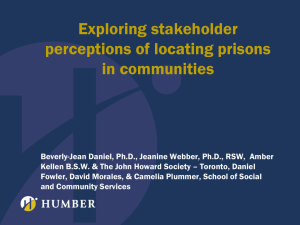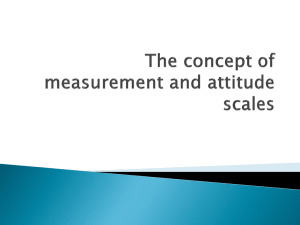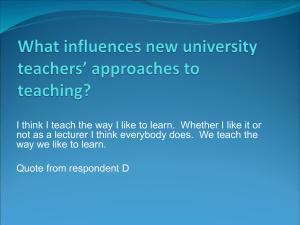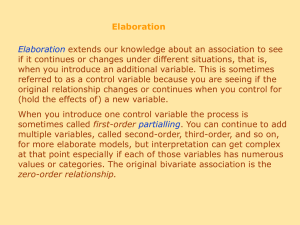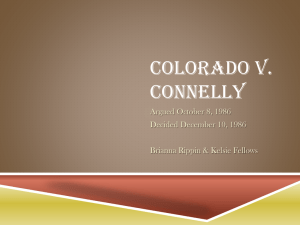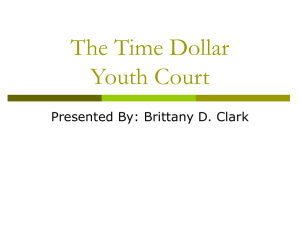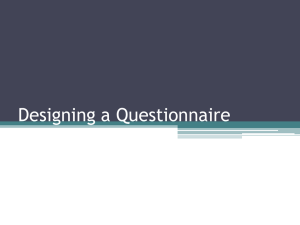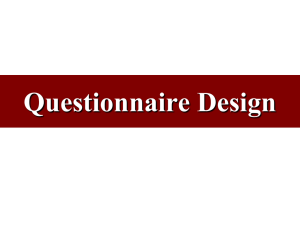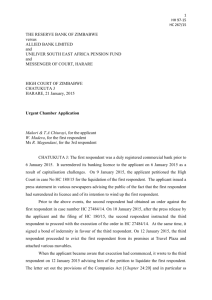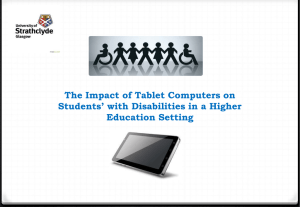PRSENTATION TITLE
advertisement
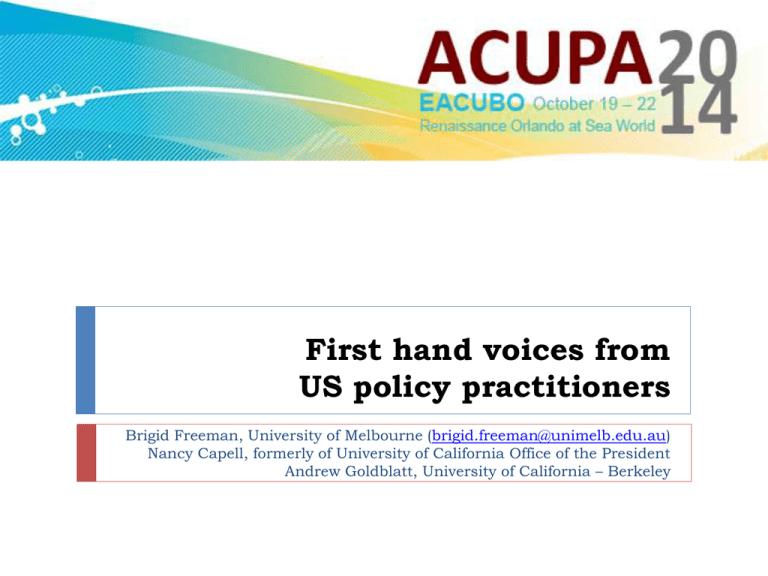
First hand voices from US policy practitioners Brigid Freeman, University of Melbourne (brigid.freeman@unimelb.edu.au) Nancy Capell, formerly of University of California Office of the President Andrew Goldblatt, University of California – Berkeley ABSTRACT This presentation will explore responses provided by United States university policy administrators and senior institutional managers primarily through survey responses. This presentation is based on collaborative research the Institutional Policy Project - between the University of Melbourne, University of California – Berkeley, Otago Polytechnic in New Zealand, and Pacific Adventist University and Island Research and Consultants in Papua New Guinea. The presentation will consider how United States higher education institution policy practitioners conceive policy and the policy cycle. In addition, the presentation will explore the various ways in which institutions frame and conduct policy work, through policies on policy ("meta-policy"), policy repositories, and policy management approaches. METHODOLOGY Institutional Policy Project (United States) 21 interviewees 58 survey respondents Respondent involvement with policy (n=56) Note: Respondents were invited to tick all options that applied Factors leading to the development of ‘policy on policy’ (meta-policy) Meta-policy: • defines the range of policy instruments • establishes definitions • articulates the policy cycle • establishes a classification scheme • defines the application of policy • establishes approval authorities approval authorities Factors leading to the development of metapolicy (n=36) Note: Respondents were invited to tick all options that applied CONCEIVING POLICY - BROAD DEFINITIONS “A University Policy is a policy with broad application throughout the University which enhances the University’s mission, promotes operational efficiencies, reduces institutional risk, helps ensure compliance with applicable laws and regulations, promotes ethical standards and integrity, and is approved in accordance with the procedures described in this Policy. In general, University Policies include and are of a kind and nature similar to policies that are posted on [the policy repository].” [RESPONDENT] CONCEIVING POLICY OBJECTIVES “Policy that applies broadly throughout the University and pertains to more than one division of the University. University policy requires the President's review and approval and falls into three categories, namely: policy that enhances the mission of the University; policy that ensures compliance with applicable laws, rules and regulations; or policy that promotes operational effectiveness and efficiencies and reduces institutional risk.” [RESPONDENT] Your text here CONCEIVING POLICY RECORDS MANAGEMENT “University policies are maintained by the Policy Office in the policy manual. University policies often prescribe standards, requirements, restrictions, rights, or responsibilities and support the mission, values, and operation of the university. In this document, the terms policy and policies refer to university policies. Policies may not exist except at the university level. Divisions, colleges, schools, departments, programs, offices, etc. may have guidelines, practices, and standard operating procedures.” [RESPONDENT] CONCEIVING POLICY GOVERNING PRINCIPLE “The policy statement is the governing principle, plan, or understanding that guides the action. It states what we do and why, but not how. The policy statement(s) should be brief, and is supplemented by the information within the rest of the section.” [RESPONDENT] Variations in the conception of ‘policy’ reported by respondents CONCEIVING PROCEDURES Operationalize policy Frequently stepped Forms/methods Orderly administration Provide accountability CONCEIVING PROCEDURES IMPLEMENTATION “Procedures are the functional steps used to implement policies.” [RESPONDENT] “it is the how you implement” [RESPONDENT] “A defined course of proceeding – often composed of steps, using established forms or methods – to carry out a particular policy.” [RESPONDENT] CONCEIVING PROCEDURES METHODS & COMPLIANCE “Information for implementation, administration, and compliance in a consistent, efficient, and effective way. Outlines the processes, step by step, that need to be followed to comply with the policy. Outlines “how” to follow the policy. Required actions are listed according to the tasks themselves. Contains similar information to the Responsibilities section which outlines required actions according to the office or job function.” [RESPONDENT] CONCEIVING PROCEDURES METHODS & COMPLIANCE “Statement of method to be used in implementing Board Policy. It includes details of policy implementation, responsibility, accountability, and standards of practice consistent with the intent of Board Policy.” [RESPONDENT] CONCEIVING THE POLICY CYCLE Freeman et al. (2014) found that: “United States higher education managers and policy practitioners interviewed for the Institutional Policy Project conceive the policy cycle either as a “cradle to grave” policy process, or a process primarily focused on policy review. The “cradle to grave”, “life cycle” or “policy pipeline” metaphors provided by interview respondents involve the various policy cycle stages broadly including “creation – implementation – updating – review.” (p. 4) CONCEIVING THE POLICY CYCLE Freeman et al. (2014) found further that: “Conversely, the “policy cycle as policy review” view focuses explicitly on post-approval policy review processes including maintenance functions, implementation evaluation, formal review against practices, and ongoing text amendment to accommodate internal or external changes. Almost all respondents report challenges regarding the final stages of the policy cycle; that is, policy implementation, and policy implementation monitoring and evaluation (for example, absence of evaluation activity, limited evaluation capacity, dislocation between development, implementation and evaluation).” (p. 4) CONCEIVING THE POLICY CYCLE Freeman et al. (2014) found further that: “Concurrently, many respondents saw this as a challenge for policy “owners” or “responsible officers”, rather than policy practitioners centrally managing institutional policy.” (p. 4) Institutional policy cycle requirements (n=41) Note: Respondents were invited to tick all options that applied Number of policies currently overdue for review 16.7% 22.2% none between approximately 1-25% of policies in the policy library 27.8% 33.3% between approximately 26 – 50% of policies in the policy library over 50% policies in the policy library “This is the core of the problem with administrative policies at any institution of higher education in this country, and that is that, you know, the struggle between academic freedom and rules. So I mean I understand that culturally it is very, very difficult here. … I would love to be there [in Australia] where people were saying, we consider it important enough because they are checking … [to] see that we’re implementing what we say we are implementing.” [RESPONDENT] “… most of my colleagues I speak to, they have regular … review cycles but we all struggle with … getting the policy owners to actually you know to do as comprehensive a review as we would like. … I am not that aware of, you know, anyone who has standardised to the extent that any of us would like it standardised. And I think that the reason for that, I am just gonna say, … is because for the most part, those of us who want centralised policy offices … do not have the authority to say you must do it this way. Because we don’t actually own the policies.” [RESPONDENT] Number of institutions that have conducted a policy suite review (n=42) POLICY SUITE REVIEW PROJECT One respondent recommended the following: “This project needs a champion at the senior leadership level (University President or Chancellor); and a senior leader at the VP level should be charged with process leadership. Ensure appropriate delegations are in place. Form a policy process committee. Draft and get formal approval for "policy on policies." Ensure it is disseminated widely. Appoint individual who will make it happen (probably not the VP). Divide policies into areas (finance, HR, IT, academic etc) and categorize by level of complexity and outdatedness. Have a timeline. Assign each committee member to functional area.” [CONTINUED OVERLEAF] POLICY SUITE REVIEW PROJECT “Work with functional area to define a process that works for them. Use deadlines established by champion (President) to assure the review gets done. Make committee members accountable for her/his area and report back to committee. For those areas not making progress, invite VP to committee to discuss. Be willing to do some of the work for the functional areas, including benchmarking, drafting, scheduling meetings. Make it happen. Don't let your policies be like Latin - exist in a book somewhere but functional areas think of them as ‘dead’.” [RESPONDENT] Resources available to support policy development or amendment (n=32) Note: Respondents were invited to tick all options that applied Resources available to support policy review (n=17) Note: Respondents were invited to tick all options that applied Institutional policy website inclusions (n=17) Note: Respondents were invited to tick all options that applied Human resources available (n=33) Note: Respondents were invited to tick all options that applied CHARACTERISTICS OF A GOOD POLICY DEVELOPER “Knowledgeable about multiple aspects of the university; clear communicator; effective organizer; good judgment about policy implications.” [RESPONDENT] “Balance of attention to big picture and detail; open to feedback; good plain language writer; not sexist; knows what they know and what they don't know.” [RESPONDENT] More CHARACTERISTICS OF A GOOD POLICY DEVELOPER “Ability to listen to policy stakeholders and translate their needs and wants into a written document. Ability to understand business process (both in positive and negative circumstances).” [RESPONDENT] “Thorough knowledge and understanding of topic; good writing skills; ability to interact and garner feedback from constituents.” [RESPONDENT] Clusters of policy-related responsibilities The authors suggest that efforts to encourage increased activity in one area should be clear about where institutional responsibility lies, at what points policy practitioners can appropriately provide support, and how policy practitioners can develop intervention strategies accordingly. CONCLUSIONS Based on the survey responses and interviews, the authors conclude the following: • • • • • United States practitioners draw a distinction between responsibility for administrative policy and responsibility for academic policy. Comprehensive meta-policy can go some way towards embedding good policy practices. Conceptions of policy are dependent on context (position, institution type, level of expertise) United States practitioners have good policy development skills. However, this focus on policy development may be to the detriment of the required focus on policy implementation evaluation and review. Policies need to reflect practice. [continued overleaf] Based on the survey responses and interviews, the authors conclude further that: United States higher education institutions have range of institutional policy resources, libraries and websites, many of which are publicly accessible for newcomers interested in establishing quality policy systems. Policy borrowing, ACUPA initiatives, institutional policy research, and fruitful international collaborations can go some way to propagating good practices to compensate for the perpetual shortage of policy-related resources. Thank you for your participation. Questions or comments?
